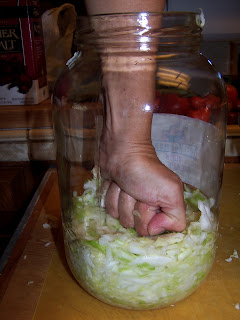And since there was a nice big pile of dirty pots and pans in the sink from my canning project yesterday, I thought today would be the perfect day to clean the bathrooms (and then spend more time blogging about it). The dishes will still be there later, right? The unfortunate answer to that question is always "yes."
Off I headed to the FOUR bathrooms in the house to scrub and clean. My usual weekly regimen is to just wipe down everything with a disinfectant wipe and scrub the toilet with bleach. But, since it's been at least a week since I really scrubbed them down (ok, more like three weeks...... don't judge me), I decided to do a really good job. Besides, I have this really big pile of dishes waiting for me, so the longer it takes to clean the bathrooms, the better.
I've been learning all about the natural germ killers, like vinegar, so I've been trying to use less and less commercial cleaners.
According to Wikipedia,
"Vineagar is reputed to have strong antibacterial properties. One test by Good Housekeeping's microbiologist found that 5% vinegar is 90% effective against mold and 99.9% effective against bacteria,[48]"
I make a cleaner that I use for just about everything. (See original post HERE )
All Purpose Cleaner
16 oz spray bottle
add 2 Tbsp vinegar, 1 tsp Borax, and some warm water
swirl until borax is dissolved
add a few drops of dish soap (Dawn)
fill the bottle with warm water
(I use a 32 oz bottle from an old cleaner that I had, so I just double the recipe. You can adjust for the size spray bottle you have).
Nice fancy label, right?
I even made my own Orange Infused Vinegar to add the cleaning power of orange oil to the concoction.
Orange oil "is also an effective, environmentally friendly, and relatively safe solvent, which makes it an active ingredient of choice in many applications, such as, but not limited to, adhesive and stain removers, cleaners of various sorts, and strippers." Wikipedia.
Orange Vinegar
Collect orange peels and allow them to air dry (toss any that grow mold)
Break up the orange peels and put them in a jar
Fill jar with vinegar
Seal jar and set aside for 2 weeks
Strain orange peels out and keep sealed in a dark location
I use this spray to clean countertops, showers, and the floor. So far I've been really happy with it. I ran out of it today, so my 4 year old daughter helped me make some more (she loves to stir and mix things).
Before I knew it, the bathrooms were clean. I couldn't stop there, though, because I needed to put off the dishes for just a bit longer.
I'm always on the lookout for new cleaning recipes to try, and I've been looking for a new disinfectant spray. I came across a recipe for a thyme based disinfectant. (See original post HERE)
"Oil of thyme, the essential oil of common thyme (Thymus vulgaris), contains 20-54% thymol.[5] Thyme essential oil also contains a range of additional compounds, such as p-Cymene, myrcene, borneol and linalool.[6] Thymol, anantiseptic, is the main active ingredient in various commercially produced mouthwashes such as Listerine.[7] Before the advent of modern antibiotics, oil of thyme was used to medicate bandages.[1] Thymol has also been shown to be effective against various fungi that commonly infect toenails.[8] Thymol can also be found as the active ingredient in some all-natural, alcohol-free hand sanitizers." Wikipedia.
Since I have a TON of thyme in my garden, it was really easy and cheap to whip up.
Thyme Disinfectant
Boil 5 sprigs of thyme in 2 cups of water
Turn off heat and cover, allowing the thyme to soak in hot water for 30 minutes.
Pour in a spray bottle and add 1/4 cup Borax (shake to dissolve).
How much is a sprig? I don't really know... I just grabbed a bunch. More is better when it comes to disinfecting power (in my opinion).
How easy is THAT? And is smells really nice too.
So, my bathrooms are clean and I have a new disinfectant spray to try. These cleaners are so easy to make and do such a good job, that I still have enough time to do all of my dishes before picking up my son at school.
Darn it!












